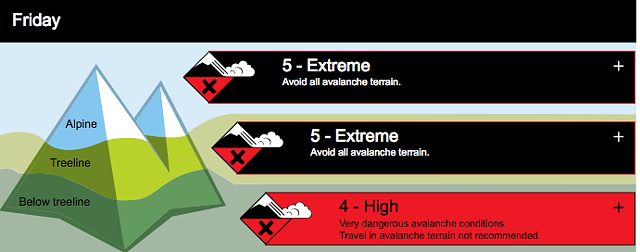âVery large avalanches are almost certainâ on Friday, Jan. 3, warned Avalanche Canada in an uncommon extreme avalanche warning issued for the Sea-to-Sky mountains.
In a statement, the organization said it ârarely seesâ the danger rating rise to extreme, and, on its website, urged the public to avoid all avalanche terrain as âintense precipitation will form large storm slabs and add tremendous stress to an already wet snowpack.â
âWe typically see extreme ratings about once or twice per year and thatâs across all of Western Canada,â added Avalanche Canada forecaster Simon Horton in a follow-up call.
The extreme danger rating for Friday applies to the treeline and alpine areas in the backcountry, and lowers to âhighâ through the weekend.
It went on to say that avalanches have the potential to run long distances and destroy mature timber. Itâs the combination of âa very high probability of avalanches and the fact that the avalanches are expected to be very largeâ that has resulted in the rare extreme rating, Horton explained.
While the greatest risk was posed during the âpeak intensityâ of Friday morningâs storm, large natural avalanches are âlikelyâ through the day and the rest of the weekend, Avalanche Canada said.
Approximately 40 centimetres of snow fell around Whistler between Thursday night and midday Friday, combining with freezing rain and strong southwesterly winds.
A weaker New Yearâs Day storm deposited about 40 cm of snow above a layer of surface hoar, which led to âreactive storm slabsâ in the past few days. Multiple weak layers are buried deeper in the snowpack, the forecast said, including a variable layer of surface hoar and crust from mid-December as well as âa deeper layer of sugary facets and crustâ from late-November.
"Itâs been quite stormy for the last few weeks but the fall was relatively dry, so that set up a weak snowpack structure, so when there was little snow on the ground in November and early December, it formed a lot of weak snow, and since then, these past few weeks when itâs been snowing harder, the bottom of the snowpack isnât able to support the weight of this new snow,â Horton noted. âWeâve seen what we call âpersistent slab avalanches,â which are much thicker than what youâd typically get just during a storm.â
A second intense storm is in the forecast for Friday evening, expected to bring another 30 to 50 cm of snow above 700-metre elevation by Saturday afternoon. Another storm is expected to bring 15 to 30 cm of snow on Sunday.
At Whistler Blackcomb, all upper alpine terrain remains closed. Both the Peak 2 Peak and the upper portion of the Blackcomb Gondola are also closed. At press time, all skiing and riding has been relegated to ârestaurant-level and below,â said Marc Riddell, Vail Resortsâ West Coast communications director.
Riddell advised the public to obey all signage and rope lines to stay safe. âTheyâre there for a reason,â he said.
Avalanche mitigation will likely continue at Whistler Blackcomb on Friday and Saturday âbefore we make any decision as to whether or not weâre going to open the alpine,â Riddell noted.
To read the full avalanche warning and forecast, visit .
Ìý
Read the original article .



